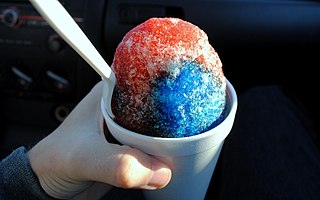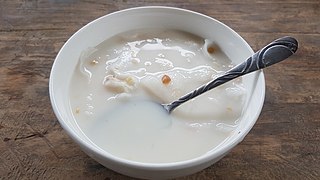
Dessert is a course that concludes a meal. The course consists of sweet foods, such as confections, and possibly a beverage such as dessert wine and liqueur. In some parts of the world, such as much of Greece and West Africa, and most parts of China, there is no tradition of a dessert course to conclude a meal.

Filipino cuisine is composed of the cuisines of more than a hundred distinct ethnolinguistic groups found throughout the Philippine archipelago. A majority of mainstream Filipino dishes that compose Filipino cuisine are from the food traditions of various ethnolinguistic groups and tribes of the archipelago, including the Ilocano, Pangasinan, Kapampangan, Tagalog, Bicolano, Visayan, Chavacano and Maranao ethnolinguistic groups. The styles of preparation and dishes associated with them have evolved over many centuries from a largely indigenous base shared with maritime Southeast Asia with varied influences from Chinese, Spanish and American cuisines, in line with the major waves of influence that had enriched the cultures of the archipelago, as well as others adapted to indigenous ingredients and the local palate.

Chocolate syrup is a sweet, chocolate-flavored condiment. It is often used as a topping or dessert sauce for various desserts, such as ice cream, or mixed with milk to make chocolate milk or blended with milk and ice cream to make a chocolate milkshake. Chocolate syrup is sold in a variety of consistencies, ranging from a thin liquid that can be drizzled from a bottle to a thick sauce that needs to be spooned onto the dessert item.

Halo-halo, also spelled haluhalo, Tagalog for "mixed", is a popular cold dessert in the Philippines made up of crushed ice, evaporated milk or coconut milk, and various ingredients including ube jam, sweetened kidney or garbanzo beans, coconut strips, sago, gulaman (agar), pinipig, boiled taro or soft yams in cubes, flan, slices or portions of fruit preserves and other root crop preserves. The dessert is topped with a scoop of ube ice cream. It is usually prepared in a tall clear glass and served with a long spoon. Halo-halo is considered to be the unofficial national dessert of the Philippines.

Shaved ice is a large family of ice-based desserts made of fine shavings of ice or finely crushed ice and sweet condiments or syrups. Usually, the syrup is added after the ice has been frozen and shaved—typically at the point of sale; however, flavoring can also be added before freezing. The dessert is consumed worldwide in various forms and ways. Shaved ice can also be mixed with large quantities of liquid to produce shaved ice drinks.

Kalamay, is a sticky sweet delicacy that is popular in many regions of the Philippines. It is made of coconut milk, brown sugar, and ground glutinous rice. It can also be flavored with margarine, peanut butter, or vanilla. Kalamay can be eaten alone but is usually used as a sweetener for a number of Filipino desserts and beverages. It is related to the Chamorro dessert called Kalamai.

Sorbetes is a traditional ice cream originating from the Philippines and uniquely characterized by the use of coconut milk and/or carabao milk. Often pejoratively called "dirty ice cream", it is distinct from the similarly named sorbet and sherbet. It is traditionally peddled in colorful wooden pushcarts by street vendors called "sorbeteros". It is served in various flavors in small wafer or sugar cones and more recently, as a pandesal bread ice cream sandwich.

Binignit is a Visayan dessert soup from the central Philippines. The dish is traditionally made with glutinous rice cooked in coconut milk with various slices of sabá bananas, taro, ube, and sweet potato, among other ingredients. It is comparable to various dessert guinataán dishes found in other regions such as bilo-bilo. Among the Visayan people, the dish is traditionally served during Good Friday of Holy Week.

Brazo de Mercedes is a traditional Filipino meringue roll with a custard filling typically dusted with powdered sugar. It is a type of pianono.

Namkhaeng sai is a Thai version of shaved ice or snow cone. It is also known as wan yen or chamba. Namkhaeng sai is simply shaved ice in a bowl, poured on top with sweet syrup and condensed milk

Ube halaya or halayang ube is a Philippine dessert made from boiled and mashed purple yam. Ube halaya is the main base in ube/purple yam flavored-pastries and ice cream. It can also be incorporated in other desserts such as halo-halo. It is also commonly anglicized as ube jam, or called by its original native name, nilupak na ube.

Mango float or crema de mangga is a Filipino icebox cake dessert made with layers of ladyfingers (broas) or graham crackers, whipped cream, condensed milk, and ripe carabao mangoes. It is chilled for a few hours before serving, though it can also be frozen to give it an ice cream-like consistency. It is a modern variant of the traditional Filipino crema de fruta cake. It is also known by various other names like mango refrigerator cake, mango graham float, mango royale, and mango icebox cake, among others. Crema de mangga is another version that additionally uses custard and gulaman (agar) or gelatin, as in the original crema de fruta.

Samalamig, also known as palamig, is a collective term for various Filipino sweet chilled beverages that usually include jelly-like ingredients. They come in various flavors, and are commonly sold by street vendors as refreshments. Typical ingredients of the drinks include gulaman (agar), sago pearls, kaong, tapioca pearls, nata de coco, and coconut. They are usually anglicized as pearl coolers or pearl and jelly coolers.

Minatamis na saging is a Filipino dessert made with chopped saba bananas cooked in a sweet syrup (arnibal) made with muscovado sugar and water. Some recipes also add a little bit of salt and pandan leaf or vanilla extract. Other ingredients can also be added like sweet potato, sago, or other fruits like jackfruit. It can be eaten on its own or added as an ingredient to other desserts. Adding the dessert over milk and shaved ice also results in another dessert known as saba con yelo.
Ice buko, also known as buko ice candy or coconut popsicle, is a Filipino frozen dessert made from condensed milk, young coconut (buko) strips, and coconut water. It is basically a frozen version of the buko salad. They can be sold on popsicle sticks or in plastic bags as ice candy. They commonly include other ingredients like peanuts, pinipig, macapuno, pandan leaf extracts, various fruits, or sweetened mung beans. They are popular desserts during the summer and are commonly sold by sari-sari stores and sorbeteros.

Buko salad, usually anglicized as young coconut salad, is a Filipino fruit salad dessert made from strips of fresh young coconut (buko) with sweetened milk or cream and various other ingredients. It is one of the most popular and ubiquitous Filipino desserts served during celebrations and fiestas.

Lamaw, also known as buko lamaw, is a Filipino dessert or beverage made from scraped young coconut meat (buko) in coconut water with milk and sugar, and saltines or biscuits. Variations can add ingredients like peanuts, graham crackers, or orange-flavored softdrinks. Ice cubes are also commonly added to chill the dessert. It is usually made from freshly gathered coconuts, and is commonly served within the coconut shell itself. It originates from the Visayas and Visayan areas of Mindanao and is a traditional merienda for farmers working in the fields in rural areas.

Ube ice cream is a Filipino ice cream flavor prepared using ube as the main ingredient. This ice cream is often used in making the dessert halo-halo.

Avocado and milk in ice is a traditional Filipino dessert or beverage made from avocado in milk and sugar. It is preferably eaten cold. Ice are added, or it is partly frozen before consumption. The milk can also be excluded, mixing avocados directly with sugar. The avocados can also be mashed or puréed, which is usually called avocado milkshake or avocado smoothie. Sliced dessert bananas are sometimes added.



















